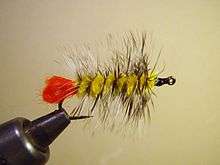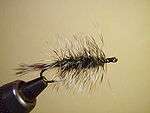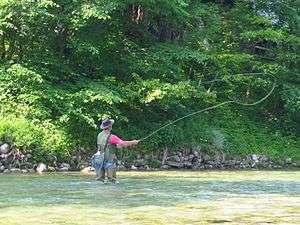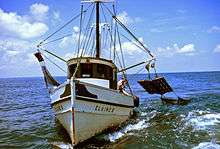Woolly Worm (imitation)
The Woolly Worm is an artificial fly commonly categorized as a wet fly or nymph and is fished under the water surface. It is a popular pattern for freshwater game fish and was a very popular fly in the 1950s–1970s in the west. Charles Brooks in Nymph Fishing for Larger Trout recommends the Woolly Worm as a general purpose nymph pattern in most western trout waters in any fly box. Woolly Worms are typically fished in streams, rivers, ponds, and lakes for trout, bass, and panfish. Today, Woolly Worms are tied in a variety of styles and colors to imitate a large aquatic nymphs such as stoneflies, dragonflies, damselflies or hellgrammites.
| Woolly Worm | |
|---|---|
| Artificial fly | |
 Yellow and Grizzly Woolly Worm tied in its classic form | |
| Type | Wet fly, nymph |
| Imitates | large aquatic nymphs of stoneflies, dragonflies, damselflies or hellgrammites |
| History | |
| Creator | Unknown, popularized by Don Martinez (1950s) |
| Created | 1920s |
| Variations | Tied with various body, tail and hackle colors, weighted and unweighted |
| Materials | |
| Typical sizes | 6-12 |
| Thread | Black 6/0 |
| Tail | Short red yarn |
| Body | Chenille in black, yellow or green |
| Ribbing | Gold wire (optional) |
| Hackle | Grizzly neck or saddle |
| Head | Black thread |
| Uses | |
| Primary use | Trout, Bass, Panfish |
| Reference(s) | |
| Pattern references | Woolly Wisdom (2005), Soucie[1] |
Origin
The original Woolly Worm pattern is said to have originated in the Ozarks as a bass fly. Its real popularity however came when Don Martinez, a West Yellowstone, Montana fly tier commercialized the pattern in the 1950s.[1]
Imitates
The Woolly Worm, depending the specific material used and how it is fished can be assumed to resemble large nymphs, more specifically stoneflies, dragonflies, damselflies, riffle beetle larvae or hellgrammites.[1][2][3][4]
Materials
The original Woolly Worm fly was constructed without a tail, but the contemporary pattern has a yarn tail or hackle fiber tail. The body is a chenille or fur body with a hackle palmered from the tail to the head of the fly. The underbody may be weighted with lead wire. The popular colors are yellow, olives, browns, blacks. The most common hackle used is grizzly.
Variations and sizes
Woolly Worm flies are typically tied on number 4 to 10 3X long hooks. Variations include Woolly Worms weighted with lead underbodies or brass or tungsten beads.
- Black and Brown Beadhead Woolly Worm
.jpg) Black Woolly Worm with a red hackle tail
Black Woolly Worm with a red hackle tail Grizzly and Olive Woolly Worm
Grizzly and Olive Woolly Worm
References
Soucie, Gary (2006). Woolly Wisdom. Portland, Oregon: Frank Amato Publications. ISBN 1-57188-352-5.
Notes
- Soucie, Gary (2006). Woolly Wisdom. Portland, Oregon: Frank Amato Publications. pp. 10–11. ISBN 1-57188-352-5.
- Cordes, Ron; Kaufmann, Randall (1984). Lake Fishing With A Fly. Portland, Oregon: Frank Amato Publications. pp. 92–93. ISBN 0936608269.
- Stewart, Dick; Allen, Farrow (1992). Flies for Bass and Panfish. Inervale, NH: Northland Press Inc. p. 58. ISBN 0-936644-10-9.
- Murray, Harry (1989). Fly Fishing For Smallmouth Bass. New York: Nick Lyons Books. pp. 141, 155, 160. ISBN 0-941130-85-1.

